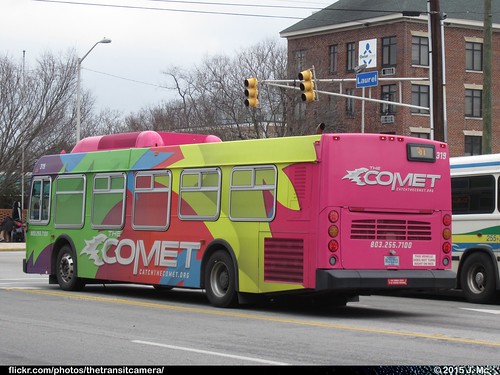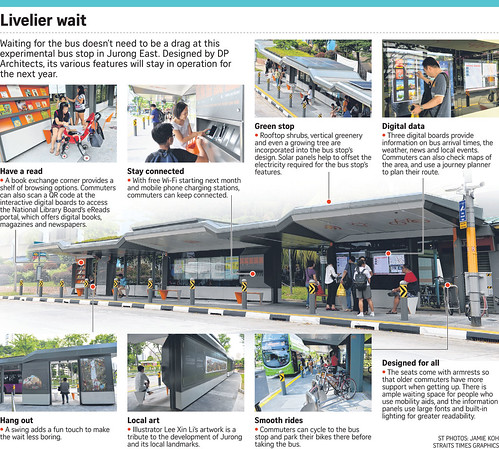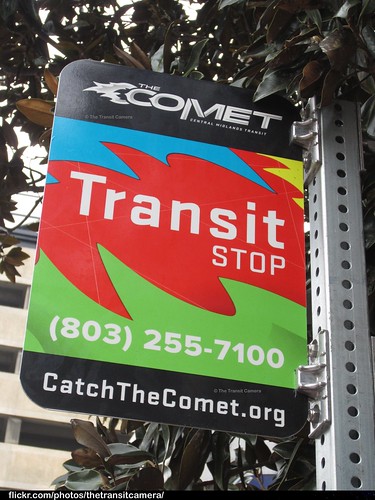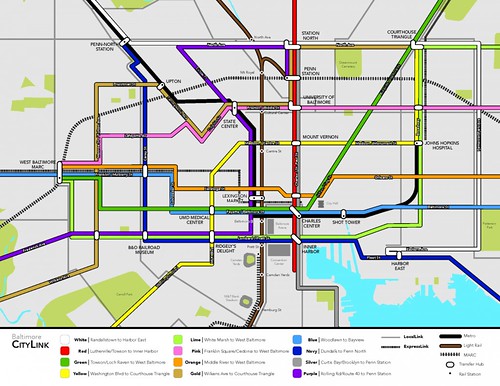Thinking systematically about bus transit service improvements: spurred by Columbia SC, Edmonton AB, and Baltimore
Charging ports on new buses in Columbia, SC. Photo: Tim Dominick, Columbia State newspaper.
The Columbia State reports ("This new Columbia ride is smoother, has Wi-Fi and lets you pay with an app") on new buses at the local transit agency, the Central Midlands Regional Transit Authority, operating as Comet. Getting new buses tends to be ordinary, not really newsworthy.
But the new buses added to the fleet offer significant advances in on-board amenities and fare collection, so are an upgrade in terms of customer service too.
The buses have free to use wifi and charging ports, along with security cameras, and IT capabilities to capture real-time data about performance. The data will be used by transit operators to improve service, but will also be made available to riders, using an app called TransLoc (I think that's the app is used by the Go Transit services in Raleigh-Durham too).
Plus the fareboxes are outfitted to accept smartphone payment apps!
Wifi has been made available on buses for awhile, but for transit agencies, it's still a new service. I haven't heard of charging ports being offered on buses, nor have I come across many examples of smartphone-enabled payment options at the farebox, so these are significant improvements.
The new buses are being paid for by a county sales tax add-on for transportation, which has been levied since 2012. It pays for transit (bus) and road improvements and expansion of a trail network.
A framework for bus service improvement. It makes me realize while I discuss in so many ways how to improve bus service in the 2012 entry "Make Bus Service Sexy and More Equitable," a more robust framework is required to outline bus service improvements in a more systematic way.
This also comes up in the DC area as starting on Sunday June 25th bus fares increase simultaneously with many service cutbacks ("It's about to get more expensive to ride the bus," Washington Post). And yesterday the Maryland Transit Administration launched its new BaltimoreLink reconceptualization of transit service in the Baltimore area ("Some bumps in the road for bus riders as BaltimoreLink hits city streets," Baltimore Sun).
Note that I haven't gotten around to reading this article from McKinsey, "The expanding role of design in creating an end-to-end customer experience."
Amenities inside the bus. The changes in Columbia make me realize that I haven't thought about this enough in terms of improvements to the transit rider experience "inside the bus." The 2012 entry mentions having bus system maps on the bus and maybe better accommodations for strollers/packages. But that's about it.
Branding-identity improvements. The Columbia transit system, called the Comet, has a design forward bus livery and transit stop signage. Transport for London has "product design managers" for the different "lines of business" such as "bus service."
-- "The Sign Design Society Event: Defining a City," designworkplan
-- Product design guidelines, Transport for London
From the presentation by Ivan Bennett, Design Manger for London Buses:
One reason other systems have failed is the lack of continuity. London bus stops extend beyond central areas and cover all routes in Greater London. Ivan indicated that passengers do not just want information about where they are travelling from, but when they get there, they need the same consistently presented information. People need information near their homes and local areas, not just in the centre of the city.

Bus shelter/bus stop improvements/bus transit stations. Many past entries discussed bus shelters but there are newer developments in bus shelters outside of public art expression and more along the lines of broader urban design and placemaking improvements to communities such as in the Jurong district of Singapore ("Jurong bus stop makes waiting fun,"Straits Times).

Most transit stop signage is pretty dull. The COMET system extends their "not boring" bus livery design to the signage at bus stops.

Transit stations are another element of the mix, and exist at various sizes. In the DC area, there are a handful of bus-only transit stations. Many rail transit stations also function as significant transfer points to bus service.
Fare equity. I am embarrassed that most of my earlier entries on "transit wish lists" and the like didn't address making lower cost transit pass options for lower income households. Many areas have special youth passes (DC and Montgomery County Maryland among them, more recently San Francisco, "Free Muni for low-income youth starts Friday," San Francisco Chronicle).
And San Francisco has had for awhile a specially priced transit pass for low income residents called the Lifeline Pass--it's half the price of the regular monthly pass. More recently, Seattle has introduced a similar program called ORCA Lift, although it is per ride, but about half the cost of a regular fare ("Seattle Cuts Public Transportation Fares For Low-Income Commuters," NPR).
The one thing I say about such fare pricing is that there should be funds provided locally for this subsidy, separate from the general appropriations for "transit service."
Edmonton Transit is introducing a new fare media system that like the Oyster card system in Greater London, can calculate "maximum fare costs for riders." London does it for riders who don't have weekly or monthly passes, but based on the cost of a daily transit pass.
In the case of Edmonton, for low income riders who can't afford to buy a monthly pass in advance, the "rate capper" will work over the course of an entire month, and once a rider pays in fares the equivalent of the cost of a monthly pass, the pass -- and "free" travel for the rest of the month kicks in ("New smart cards for Edmonton Transit boast a 'social justice' edge," Edmonton Journal).
From the article:
People with steady jobs and good paycheques are the most likely to buy a monthly pass. They have cash on hand at the beginning of the month.While the transit agency is adding the capability of "capping" to their fare media system, Council approval must be obtained before the program can be implemented.
Those who might need their last nickel just to keep the lights on are the most likely to pay cash for every trip. It means they pay $3.25 per ride, more money for the same service.
That’s one reason Ken Koropeski is excited about Smart Fare.
With a card and an online account, the system can track how many times a person uses transit during a 30-day period, said Koropeski, director of special projects for Edmonton Transit. No one would have to commit to a monthly pass on Day 1. Instead, the system could automatically track use and once the rider hits that monthly maximum, all other rides are free.
“When you have capping, it has inherent benefits for people with low income,” said Koropeski.
Urban design and access improvements. The VIA transit agency in San Antonio incorporates urban design thinking into its strategic planning unit.
According to Christine Vina ("VIA urban planner wants to build a better San Antonio," San Antonio Express-News):
I don’t consider VIA “a bus company.” It’s a transit agency that connects people with places through sustainable transportation options. But that’s too long for a business card.Northgate Transit Station, Edmonton. Photo by Tom Braid.
VIA’s Strategic Planning Division, for example, analyzes the projected transit needs of the community over the next five to 25 years and develops projects that respond to the need for transportation alternatives. This allows people to reduce their vehicle travel, and increase their options for living, working and playing — which provides the opportunity for an enhanced quality of life.
As an architect and urban planner, I manage VIA’s joint development and public art programs, so I’m fortunate to be able to work as a liaison to creative architects, landscape architects, planners, artists and developers who we contract with to design and build our capital projects. Through good design, we increase the value of the role our facilities play in contributing to the built environment.
People are complaining in Edmonton that they have some great new transit stations, but the stations don't do much in the way of changing the mobility paradigm towards sustainability, that the stations extend the automobility paradigm because while they might look nice (public art treatments) access requires walking across many lanes of traffic, etc. ("Edmonton bus terminals fall short for pedestrians, says mayor," Edmonton Journal). That's a matter of urban design and access.
Maps, schedules, real-time information, etc. We can't forget the need to have printed products as well as online apps, real-time data at stations and stops, etc. Many of these items are covered in my "critique" of the then newly opened akoma Langley Crossroads Transit Center from December 2016.
Transit network breadth and depth. While listed last, this is the most important element. I argue that network breadth, network depth, level of service (LOS) and level of quality (LOQ) standards and expectations should be produced by the area's "Metropolitan Planning Organization" separate from the transit agency or agencies. That would mean the service footprint and standards would be set independently.
The King County Metro Transit (Washington State) Service Guidelines are a good model.
This is important because too often decisions are "satisficed" because of budget limitations. That's an issue in the DC area, as service declines in Metrorail have resulted in lower ridership for both the rail and bus systems, which has reduced "farebox revenue" further stressing the system's finances.
But service cuts when not done judiciously, can further result in ridership declines.
Transit network legibility: differentiating between express; local; and high-frequency service. Bus systems should reconfigure their service footprint every so often. By defining the type of service--technically bus rapid transit is a form of high frequency service, but with limited stops, so it's a hybrid of express and high-frequency, but usually charged at a regular fare--and creating the right set of routes, ideally maximum ridership is achieved, accomplishing breadth, frequency, service, and quality goals and objectives.
A number of bus systems are implementing changes such as Richmond ("City to rethink GRTC routes, largely unchanged since trolley days," Richmond Times-Dispatch) and Baltimore. From the Baltimore Sunarticle:
Some people balked at the confusing changes, while others welcomed them. Everyone enjoyed the free rides being offered for the system's first two weeks. ...
BaltimoreLink is based around a dozen color-coded, high-frequency CityLink routes running every 10 minutes through downtown Baltimore, connected to less frequent LocalLink and weekday ExpressLink commuter buses.
The overhaul, the first re-routing of the system in decades, is designed to modernize routes and connect buses to where people go, whether it's jobs, entertainment or other transit. In addition to redesigning the routes, wrapping the buses in the Maryland flag colors and unveiling 5,000 new bus stop signs, the MTA added bus-only lanes and traffic-light sensors aboard buses to shorten red lights and extend green ones to get the buses more quickly through traffic congestion.

New transit service map for the City of Baltimore.
Transit prioritization on roadways. As integrated into the new BaltimoreLink service, exclusive transitways, traffic signal control, and other methods help transit buses (and streetcars/light rail) move more quickly and better balance transit vehicles recognizing that they carry many more people.
Exclusive bus lane in Downtown Baltimore. Baltimore Sun photo.
Also see "MTA officials pull all-nighter for 3 a.m. launch of $135 million BaltimoreLink bus route overhaul" and "New MTA head Kevin Quinn: 'We're ready for launch' of BaltimoreLink," Baltimore Sun.
For example, in DC it has been a struggle to develop bus exclusive lanes, but on streets like 16th Street, Georgia Avenue, and H Street, buses carry 40% to 50% of the total people throughput. On Georgia Avenue and H Street, about 300 bus runs move 15,000 people trips, while 20,000 motor vehicles move 20,000 to 25,000 people.
Toronto is prioritizing streetcar service on King Street--the line has 65,000+ daily riders--but not without some controvery ("Ford's costly streetcar study will just reveal the obvious," Toronto Star).
Minneapolis is introducing urban design improvements to the Nicolett Transit Mall ("Nicollet Mall likely to reopen this fall after two years of work," Minneapolis Star-Tribune).
-- Nicolett Mall Project
Bus rapid transit, to meet the definition, is supposed to have exclusive rights of way.
Transit network: intra-district service. I write about what I call the "tertiary" transit network of service within neighborhoods. Other intra-district service like Circulators can be part of the primary or secondary transit networks of a community or metropolitan area ("Making the case for intra-city (vs. inter-city) transit planning").
While I tout the Tempe Orbit service as the premier example of intra-district multi-neighborhood bus service ("Earth Day and Intra-neighborhood transit"), Edmonton is discussing this kind of service in the context of providing better service to seniors ("Four ways to keep Edmonton seniors walking from transit." Edmonton Journal), albeit with a fare upcharge. From the article:
Community busesAnd I've discussed micro-transit services, particularly shuttles, as part of mobility services in commercial districts, aimed at getting people to park in parking structures so that street right of way can be used for purposes other than car storage ("Intra-neighborhood (tertiary) transit revisited because of new San Diego service").
If the bus service focuses on main streets and express routes, transit officials say service inside neighbourhoods should focus on key destinations for people with mobility challenges. They’ll design a sample route to present to the urban planning committee with the larger changes June 7.
That will be critical, said Walters. Some residents in Lendrum were upset last September when service cuts to Routes 55 left them with no way to get to the neighbourhood strip mall.
But transit officials returned to ask residents which destinations are most important. The new changes, set to be rolled out this coming September, will reduce service to once an hour but cover more of the neighbourhood. It’s a good example of what’s possible.
In the future, a community bus ticket might cost extra because it’s a niche service requiring extra resources per rider, said Walters. But research out of the University of Alberta suggests many seniors are willing to pay, they just need the option.
“We’re encouraging these people to stay in their homes,” said Walters. “We need to have transportation options when they can no longer drive their own private vehicle.”
Equity of access. Another element of transit service is equitable access. Outside of major cities, transit service is seen more as a form of social services for people who can't afford to own a car rather than as a preferred mobility choice and a way to manage optimal use of the road network.
Where services go, providing access to employment opportunities and other destinations, hours of operation, etc., may all involve questions of equity. The Federal Transit Administration has a process called Title VI to guide consideration of these matters by transit agencies.
Sometimes this is about providing service to suburban locations from cities, sometimes it has to do with whether or not a desired destination like a shopping center, will allow on-site access to transit vehicles, but most often it comes up with fares and service hours.
With regard to fares, I don't think that transit agencies should have to "keep fares low" in ways that harm the system's ability to be funded. But I do think that the "social service" function of transit--fares--as discussed above, needs to be funded from different sources than "transit," in recognition of the function and its importance.
WRT BaltimoreLink, note that some transit advocates and organizations argue that the new service footprint doesn't do enough when considered on equity grounds in terms of providing increased access to jobs. See the op-ed, "Is BaltimoreLink really better? Show us the data," from the Baltimore Sun.
Labels: bus, equity planning, transit marketing, transportation equity, transportation planning








11 Comments:
https://www.fastcompany.com/40425825/how-one-startup-is-fast-tracking-city-transit
buses are far better than riding single occupancy vehicles-but they are still noisy disgusting and cumbersome. Rail is better when at all possible. Again-I really admire what LA is doing to expand rail all over their region. They appear to be moving forward aggressively while we here in DC sit on our haunches and actually turn down new rail projects or make them hard to implement.
electric trolley buses are good too. which reminds me about the need to write about a step backwards on this dimension in Wellington, New Zealand. (One of my e-correspondents lives there.)
"sustainability" should be another element.
Your own ideas tend to be amazing. We frequently study your site and it is very useful.
It is a very informative and useful post thanks it is good material to read this post increases my knowledge
Uber Inspection Los Angeles
At Clicksbazaar, we offer an affordable yet the most effective search engine optimization services in India and beyond. We actively work with our partners & associates for SEO Services in Delhi, India. With thousands of keywords in top rankings, leading brands as customers, loads of testimonials from satisfied customers, awards and certifications from industry leading bodies, you can be rest assured we know our SEO. For more digital marketing company in chennai
CTR Global combines traditional telemarketing and digital marketing services to create a new strategy that will increase its lead generation. We work with you as one of the UK's top lead generation companies uk to transform your business into a high-end brand.
Looking for the best digital marketing services in Dubai? We are here to HELP YOU. AE Clicks is one of the best digital marketing agency in UAE. We offer a fulcrum to suit your marketing needs. We aid in bringing fresh ideas that would vastly improve your customer loyalty and brand.
Steel Bird are involved in manufacturing and supplying a wide range of Two wheeler Oil filter. These are made by our experienced professionals using finest quality raw materials. our devices are widely recommended by clients owing to its purpose specific construction and longer functional life.
We are one among the best web design company in chennai. Our objective is to deliver clients with trending solutions that add values to their webpages and applications.We are Professional Website Design Services and we have efficient team of experts who are keen to complete the project within specified period. Our HTML5 developers are up to date in latest designing tools and technologies to build interactive websites.If you are looking for web designing services in chennai also you can hire web designer india we are here to help you.
Post a Comment
<< Home